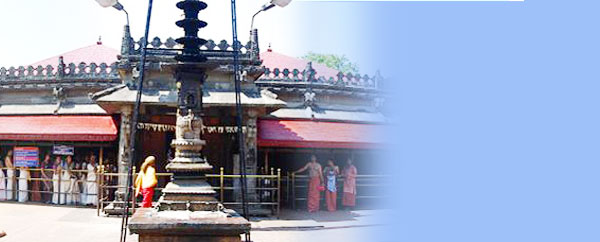Mookambika Temple (Karnataka)
It is believed that Sri Adi Shankaracharya
had a vision of Sri Mookambika Devi and he
installed the deity here.
Mookambika Temple (Karnataka) Hindu Temples

Mookambika Devi Temple of Kollur, dedicated to Mookambika Devi, is one of the most prominent shrines for people in the state of Karnataka and Kerala, India. Located at a distance of 147 km from Mangalore in the picturesque surroundings presented by the banks of the river Sauparnika and the lush green Kodachadri hill, the temple attracts millions of pilgrims every year. The temple holds immense relevance for the devotees as it is associated with revered Hindu saint and Vedic scholar Adi Shankara. It is believed that Adi Shankara perceived the idea of having a Mookambika Devi temple at Kollur and himself installed the idol of deity in the temple some 1200 years ago. People have high faith in Mookambika Devi Temple as Goddess Mookambika is regarded as a manifestation of Shakti, Saraswathi and Mahalakshmi. In fact Temple of Mookambika Devi is one of the 'Seven Muktistala' pilgrimage sites in Karnataka which are Kollur, Udupi, Subrahmanya, Kumbasi, Kodeshwara, Sankaranarayana and Gokarna.
The Mookambika Devi Temple stands on a spur of the Kodachadri peak. The deity is in the form of Jyotir-Linga incorporating both Shiva and Shakti. The Panchaloha image (five element mixed metal) of the Goddess on Shree Chakra is stated to have been consecrated by Adi Shankaracharya during his visit to this place. There is an exquisite sculpture of Panchamukha Ganesha here.
Kollur is regarded as one of the Seven Muktistala pilgrimage sites, of Parashurama Kshetra, in Karnataka which are (Kollur), Udupi, Subrahmanya, Kumbasi, Kodeshwara, Sankaranarayana and Gokarna.
Legends
According to the legends, Kola Maharshi who was doing penance here, was disturbed by a demon who was also engaged in doing penance to please Lord Shiva, to get a boon from Him. To prevent the demon from fulfilling his evil desire, Adi Shakti made him dumb (mooka) and when the Lord appeared before him, he could not ask for anything. Thereupon he got enraged and soon began troubling Kola Maharshi who prayed to Adi Shakti for deliverance. Adi Shakti who vanquished demon Mookasura, was extolled by the gods as Mookambika. At Kola Maharshi's prayer, the Divine Mother accompanied by all the Gods; stayed there to be perpetually worshipped by the devotees.
It is believed that Sri Adi Shankaracharya had a vision of Sri Mookambika Devi and he installed the deity here.The story goes like this. Adi Shankara mediated at Kudajadri hills and Devi was incarnated before him asking for his wish. He revealed his wish to incorporate devi to a place in Kerala to worship where he wanted.Devi agreed and put forward a challenge that she will follow Shankara and he should not look back until he reaches his destination.But to test Shankara devi deliberately paused and when he could'nt hear Devi's anklets,Shankara suddenly turned.Devi then stopped following him and asked Shankara to install her vigraha as he sees her.
Kollur was also a part of ancient Kerala which stretched from Gokarna to Kanyakumari.A number of myths and legends persist concerning the origin of Kerala. One such myth is the creation of Kerala by Parasurama, a warrior sage. The Brahminical myth proclaims that Parasurama, an avatar of Mahavishnu, threw his battle axe into the sea. As a result, the land of Kerala arose and was reclaimed from the waters.Parasurama was the incarnation of Maha Vishnu. He was the sixth of the ten avatars (incarnation) of Vishnu. The word Parasu means 'axe' in Sanskrit and therefore the name Parasurama means 'Ram with Axe'.
The aim of his birth was to deliver the world from the arrogant oppression of the ruling caste, the Kshatriyas. He killed all the male Kshatriyas on earth and filled five lakes with their blood. After destroying the Kshatriya kings, he approached assembly of learned men to find a way of penitence for his sins. He was advised that, to save his soul from damnation, he must hand over the lands he had conquered to the Brahmins. He did as they advised and sat in meditation at Gokarna. There, Varuna -the God of the Oceans and Bhumidevi - Goddess of Earth blessed him. From Gokarna he reached Kanyakumari and threw his axe northward across the ocean. The place where the axe landed was Kerala. It was 160 katam (an old measure) of land lying between Gokarna and Kanyakumari. Puranas say that it was Parasuram who planted the 64 Brahmin families in Kerala, whom he brought down from the north in order to expiate his slaughter of the Kshatriyas. According to the puranas, Kerala is also known as Parasurama Kshetram, ie., 'The Land of Parasurama', as the land was reclaimed from sea by him.
Other links
Hindu Temples in India
temples
Karnataka